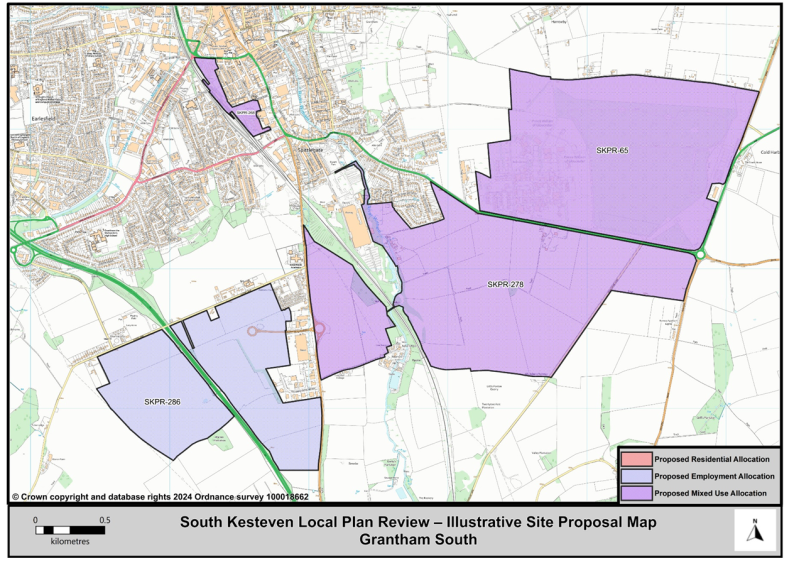Regulation 18 Draft Local Plan
(11) Chapter 9 – Employment and Economic Prosperity
9.1 This chapter sets out how the Local Plan Review will ensure that national, regional, and local aims are met in order to deliver strong and sustainable local economic growth in South Kesteven.
9.2 The Local Plan Review also seeks to ensure that well located, good quality employment land which is attractive to businesses is allocated in appropriate, accessible, and sustainable locations.
9.3 This Local Plan Review is both aspirational and realistic in supporting job creation and prosperity by taking a positive approach to sustainable local employment development.
(2) National Aims
9.4 The National Planning Policy Framework (2023) states that Local Plans should set out a clear economic vision and strategy which positively and proactively encourages sustainable economic growth, having regard to Local Industrial Strategies and other Local Policies for economic development and regeneration. The framework also seeks to ensure that Local Plans address potential barriers to investment, such as inadequate infrastructure, services or housing, or a poor environment.
9.5 In relation to planning policies, the National Planning Policy Framework (2023) makes it clear that decisions should help create the conditions in which businesses can invest, expand, and adapt. It also sets out that significant weight should be placed on the need to support economic growth and productivity, taking into account both local business needs and wider opportunities for development.
9.6 In terms of allocating land for employment development the National Planning Policy Framework (2023) outlines that Local Authorities should set criteria, or identify strategic sites, for local and inward investment to match the strategy and to meet anticipated needs over the plan period.
9.7 Furthermore, the National Planning Policy Framework (2023) recognises that planning policies should also support economic growth in rural areas in order to promote a strong rural economy, which is of primary importance to South Kesteven District as a mainly rural area.
(2) Regional Aims
9.8 SKDC is located within the Greater Lincolnshire Local Enterprise Partnership (GLLEP) which is a business led partnership made up of private and public sector leaders. These leaders work alongside National Government and key stakeholders to enable strategic projects and programmes that will drive local prosperity and economic growth across Greater Lincolnshire.
9.9 The LEP highlights that Greater Lincolnshire has the greatest proportion of grade 1 land in England, has a strong engineering heritage and has national importance in manufacturing, being home to world-class companies and supply chains. It is the LEPs initiative to drive growth of the three sectors the area has the most competitive advantage in, namely: Agri-food, Visitor Economy and Power Engineering.
9.10 The GLLEP has published a Strategic Economic Plan 2014 -2030 (SEP) which sets out the priorities for growth and the drivers of success across Greater Lincolnshire. The key areas of the SEP document are as follows;
- To drive the growth of Greater Lincolnshire's defining and strongest sectors which offer the most competitive advantage;
- To grow specific opportunities identified as 'future defining' features of the LEP area;
- To drive growth by putting expansion into new markets, modern telecommunications, infrastructure improvements and the skills of individuals and business owners, at the forefront;
- To promote Greater Lincolnshire as a place for sustainable growth through improved transport infrastructure to connect with national and international markets, enabling wider enjoyment of our world-class heritage sites, culture and strong communities; and
- To recognise the need for new housing for the local population and potential movers to the area and support balanced housing and economic development through promoting the LEP area's capacity to deliver high-quality economic growth.
9.11 The GLLEP also has additional published material such as the Local Industrial Strategy evidence base (2019) which breaks down of the sectoral composition currently within Greater Lincolnshire and the Economic Plan for Growth (2021) which is aimed at driving the revival of the Greater Lincolnshire economy post-COVID-19.
9.12 SKDC has productive and mutually beneficial working relationship with the GLLEP and has collaborated on several activities over recent years, which includes representation on the Lincolnshire Growth Hub Board, Team Lincolnshire Steering Group, submission of bid proposals for the Great British Railways Head Quarters and the Spitalgate Level Investment Zone.
(2) Local Aims
9.13 The Economic Development Strategy for South Kesteven (2016 – 2021) has reviewed the local economy in order to evaluate its strengths, weaknesses, and opportunities. It also identifies strategies for encouraging and enhancing community economic development and diversification, by setting future goals such as 'more and better' jobs to address low job density and workplace productivity; encouraging innovation and enterprise to build upon particular business strengths in sectors such as engineering, agri-food and specialist manufacturing; and making the four main towns major employment centres.
9.14 The Economic Development Strategy for South Kesteven is currently being updated for 2024-2028 and will seek to ensure the strongest economic metrics and performance throughout the District. The updated study will also set out how South Kesteven's location at the gateway of significant established and potential economic activity means it is perfectly placed to lead, and drive continued economic growth to meet the needs of incumbent and new businesses for years to come. The study also aims to provide a strong foundation and sets the ambitions on which to deliver the economic vision within South Kesteven going forward for its 143,000 residents and 6,200 businesses.
(8) The Employment Land Study 2023
9.15 As part of the evidence base for this Local Plan Review an Employment Land Study (2023) has been prepared which supersedes the Employment Land Review (2015). The new study sets out detailed evidence to demonstrate how an appropriate supply and mix of employment land and premises can be planned for.
9.16 By providing an assessment of the balance of supply and demand in the context of changing employment needs, trends and challenges the study ensures that the Local Plan Review contains sufficient land and policy approaches to maximise South Kesteven's future economic growth needs. The study also
- Provided a supply-side assessment of the quantity and quality of the district's current employment land and its suitability to continue to support employment, and establish the existing Functional Economic Market Area (FEMA);
- Assessed the likely future demand for employment space in the district over the proposed Local Plan period; and compare quantitatively and qualitatively the supply of existing land against forecast future demand; and
- Set out the evidence-based recommendations for appropriate employment land policies. This includes an assessment of recommendations for employment land policies that could support higher jobs growth scenario in the district, aligning with broader local economic growth objectives.
9.17 In terms of the overall Economic Needs assessment up to 2041, the Employment Land Study (2023) recommends that a 'Labour Demand' scenario is used when considering employment floorspace needs across South Kesteven. This scenario is based off Experian forecast modelling and Business Register and Employment Survey (BRES) data and sets out the following forecast changes over the plan period (broken down by use class type).
Table 7: Employment Use Class Type
|
Use Class type |
Forecast Change to 2041 |
|
Eg(i) |
7.1 ha |
|
Eg(ii) |
1.6 ha |
|
Eg(iii) |
11 ha |
|
B2 |
7.1 ha |
|
B8 |
52.7 ha |
|
Total* |
79.5ha |
*Total forecast change could fluctuate due to windfall and churn of employment stock
9.18 The conclusions of the Employment Land Study (2023) therefore established a need for 79.5ha of employment land to be designated (on top of currently developed designated employment sites). The Employment Land Study (2023) found that this future demand was under the amount of vacant land currently designated, which stands at 236 hectares of vacant land + 35 hectares of land with potential for intensification. It was therefore considered that no additional designation of land should be required over the Plan Period to 2041.
9.19 However, the Employment Land Study (2023) recommended that in terms of planning for any further employment land, consideration should be given to the opportunities of each site by assessing their strengths and weaknesses, as well as the surrounding context and environment when making new designations. The Employment Land Study (2023) therefore undertook an assessment into a suite of proposed employment sites across the district (both vacant and occupied) and endorsed them for either designation, retention, or release. The outputs of these endorsements were used when determining the most appropriate employment land allocations as part of the Local Plan Review.
9.20 In addition to providing the overall Economic Needs Assessment for the plan period and supplying recommendations surrounding employment land designations, the Employment Land Study (2023) also conducted a review into the employment policies of the South Kesteven Local Plan (2020). This was to ensure that the policies were still 'up to date' and suitable in terms of providing viable sustainable development when meeting the economic aspirations of the Local Plan Review.
(4) Employment Policies
9.21 The employment policies within the Local Plan Review have been based off those contained within the South Kesteven Local Plan (2020). Where appropriate, these policies have been updated to ensure that National, Regional and Local economic aims have been considered. Additionally, the Local Plan Review contains employment policies to ensure that sufficient land is allocated to maximise South Kesteven's future economic growth scenario and support broader local economic growth objectives such as high value job generation and increased inward investment. A breakdown of the employment policies has been provided in the table below.
Table 8: Employment Policies
|
Code |
Name |
|
Employment Allocation Policies |
|
|
E1 |
Grantham Southern Gateway |
|
E2 |
Employment Sites |
|
E4 |
Protected Employment Sites |
|
Other Employment Policies |
|
|
E5 |
Expansion of Existing Businesses |
|
E6 |
Loss of Employment Land and Buildings to Non-Employment Uses |
|
E7 |
Rural Economy |
|
E8 |
Other Employment Proposals |
|
E9 |
Visitor Economy |
9.22 The Local Plan Review sets out three employment allocation policies in order to respond to the outcomes of the Employment Land Study (2023) which established an up-to-date need of industrial and office floorspace in the District up to 2041. Policy E1 contains a bespoke policy for the key 'Grantham Southern Gateway' strategic employment allocation, which seeks to enhance the local economy of Grantham to attract investment and jobs in order to promote the towns status as a sub-regional centre.
9.23 Other employment allocations throughout the District are set out in Policy E2. These allocations have been endorsed by Employment Land Study (2023) are strategic in location and provide a choice to the market so that business and job growth are not constrained by the lack of suitable available sites.
9.24 Policy E4 lists a series of employment sites across the District that are to be maintained for employment generating uses. The Employment Land Study (2023) recommended that South Kesteven protects the most suitable sites to ensure that locally important employment and jobs are 'future proofed' over the plan period. All of the sites selected within policy E4 have been assessed by the Employment Land Study (2023) to ensure that they continue to be fit for employment purposes provided.
9.25 In relation to the 'other' employment policies, the expansion of existing businesses is supported through policy E5. This policy seeks to promote the wider economic aims of the district by creating the right conditions and supportive environment to help businesses expand and grow new ventures.
9.26 Policy E6 focuses specifically on retaining and enhancing employment sites across the district by setting out the importance of the allocated employment sites and employment generating buildings. Economic growth and inward investment are clearly defined as a top priority on a National, Regional and Local scale therefore, the policy seeks to protect these aspects unless specific circumstances dictate otherwise.
9.27 The rural economy is addressed in policy E7, which builds of the National Planning Policy Framework (2023) recognising that planning policies should also support economic growth in rural areas in order to promote a strong rural economy This will be supplemented by encouraging appropriate rural employment, tourist related opportunities and appropriate diversification schemes in the district's rural areas which is of primary importance to South Kesteven District
9.28 Policy E8 addresses other employment generating proposals that come forward outside of allocated employment sites. The policy takes a proactive approach; however, it should be noted that proposals for main town centre uses will be subject to a sequential test to determine if development is taking place in an appropriate location.
9.29 Policy E9 seeks to encourage sustainable growth in the district's tourism visitor economy, which in turn will support growth in the local economy. This policy supports the one of the key areas of 'strategic focus' within the Economic Development and Strategy Action Plan which focuses on enhancing South Kestevens tourism and visitor economy through the utilisation of its heritage, extraordinary buildings, sites, landscapes, and diverse collections.
(3) Policy E1 - Grantham Southern Gateway Employment Opportunity
9.30 The Grantham Southern Gateway Strategy Employment Opportunity is considered to be of strategic employment importance given its relationship to the principal growth areas of Grantham. It has suitable accessibility via the strategic road network of the A1 and the Grantham Southern Relief Road. Proposals will be encouraged that help to create an attractive and vibrant gateway to the sub-regional centre of Grantham and that assist in delivering a step-change in the quality and quantity of employment opportunities provided in the town and wider district.
Policy Type: Minor Changes to Policy
(11) E1: SKPR 286 (GR-SE1) - Grantham Southern Gateway Strategy Employment Opportunity (118.19 hectares)
Appropriate proposals for new B2 and/or B8 uses and/or redevelopment of for B2 and/or B8 uses on this Strategic Employment Site identified on the indicative Map (Figure 7) will be supported where proposals:
- do not conflict with neighbouring land uses;
- scale does not harm the character and/or amenities of the locality; and
- do not impact unacceptably on the local and/or strategic highway network.
Development proposals on this Strategic Employment Site should also:
- Create attractive landscaped edges to the western and southern boundaries, and where possible incorporate new green infrastructure;
- Bring forward development in a co-ordinated way to make the effective use of development land and highway infrastructure;
- Provide the highway infrastructure to access the site and to ensure that impact on the existing highway network is minimised, including the provision of any appropriate mitigation to the strategic highway network;
- Ensure that there are appropriate measures to enhance access and the provision of public transport to Grantham town centre;
- Provide safe and convenient highway, footway and cycleway connections throughout the Strategic Employment Opportunity, including the provision of footpaths along Gorse Lane;
- Provide appropriate surface water management including the use of Sustainable Drainage Systems wherever practicable;
- Ensure a good quality of design commensurate with the vision of creating a create an attractive and vibrant gateway to the sub-regional centre of Grantham and, regarding land immediately to the south of Gorse Lane and to the west of the A1, have building heights which respect the sensitivities of the surrounding landscape;
- Demonstrate and incorporate suitable measures, where necessary to minimise and mitigate setting impacts upon the significance of the Bowl Barrow Scheduled Monument; and
- Provide a Minerals Resource Assessment to take account of the Minerals Safeguarding Area.
Other employment generating uses that are within the E(g) use class may also be appropriate and will be considered where the promoter actively engages with the Council and an end-user for the proposal has been positively identified. Additionally the local planning authority may seek to apply conditions limiting the ability to change use to other uses within use class E without the need for planning permission.
To encourage the delivery of these sites, the Council will consider supporting initial infrastructure provision that enables the first buildings to be bought forward.
Proposals will not be supported that cause harm to the strategic employment focus of this site.
Proposed Summary of Changes
As part of the evidence base for this Local Plan Review an Employment Land Study (2023) has been prepared which supersedes the 2015 Employment Land Review. The new study sets out detailed evidence to demonstrate how an appropriate supply and mix of employment land and premises can be planned for.
Policy E1 has been amended in accordance with the 2023 Employment Land Study. A proportion of the introductory text has been positioned into the supporting text or repositioned within the policy for clarity. The policy text has been amended to reflect new E class definitions. Biodiversity Net Gain policy criteria has been added.
(17) Policy E2 - Other Employment Sites
9.31 As outlined in the National Planning Policy Framework (2023) there is a need for Local authorities to bring forward serviced land for employment use, in suitable locations, in a timeframe that meets market demands as well as the future growth requirements. Initially, the Council has identified key sites where it will particularly focus attention and work with landowners and developers to facilitate servicing the land in order to make them available for development. The strategy of policy E2 is to focus economic development on Grantham in the first instance, and then the other three market towns help to create a better balance between homes and jobs.
9.32 For Grantham, there is considerable housing growth expected in the town over the plan period which will require the creation of a considerable number of new jobs if out-commuting is to be reduced. In addition to the Grantham Southern Gateway Employment opportunity, there is some 172ha of employment generating land allocated to the north around the strategic corridor of the Gonerby Moore area. These sites will provide considerable choice to the market and create a variety of jobs through B2, B8 and acceptable E(g) proposals.
9.33 Within the market towns, Stamford is to provide for high quality modern office and ancillary uses. Whilst the redevelopment of suitable previously developed land and sites within the town centre will be a priority, it is acknowledged that additional employment land may also need to be identified. In Bourne, there is a need to match housing growth with opportunities for employment and to improve the vitality and viability of the town centre. Within the Deepings a supply of employment land will ensure that demand for sites and premises for new and existing local employment opportunities can be met.
9.34 There is also an opportunity to reduce out-commuting in the south of the District and create a sustainable pattern of development by taking into account of the strategic highway connections offered by the A1, therefore sites have also been identified near Long Bennington in the form of Roseland Business Park and off Valley Lane.
9.35 The Local Plan review allocates circa 338(ha) of new employment sites across the district. Whilst this is significantly higher than the requirement identified in the Employment Land Study (2023), the sites offer a suitable choice to the market through the identification of new land for a range of employment uses. This will ensure the further economic growth scenarios can be met by attracting substantial inward investment and providing a wide range of jobs in various sectors and industries to meet the allocated housing and population growth across South Kesteven.
Policy Type: Significant Changes to Policy
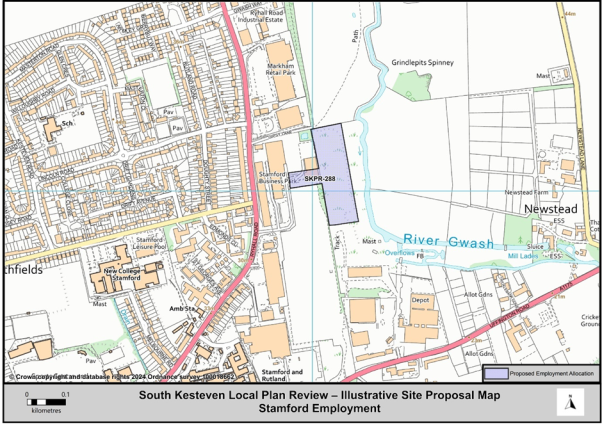
Figure 8: Stamford Employment Site
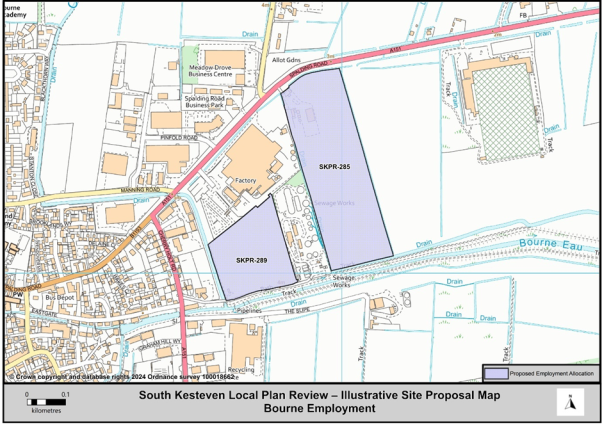
Figure 9: Bourne Employment Sites
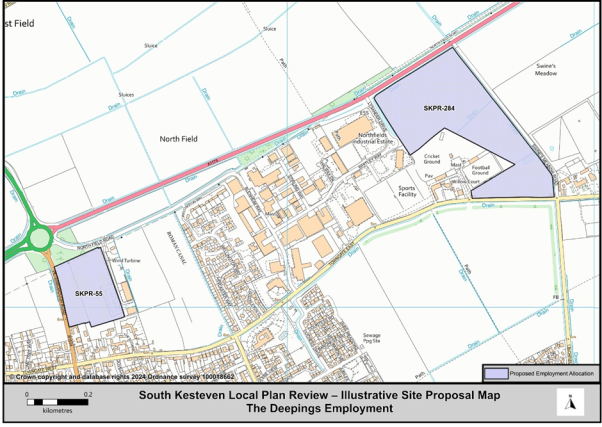
Figure 10: The Deepings Employment Site
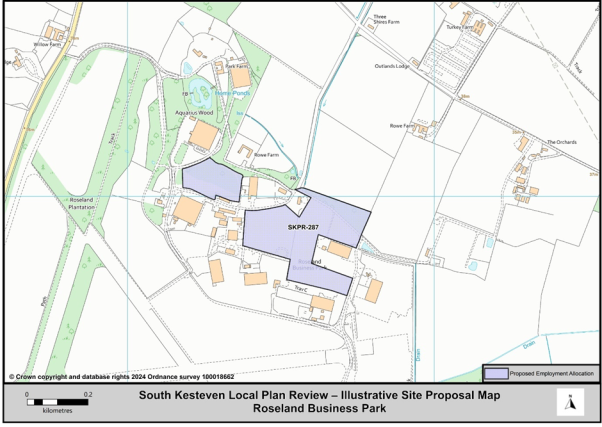
Figure 11: Roseland Business Park
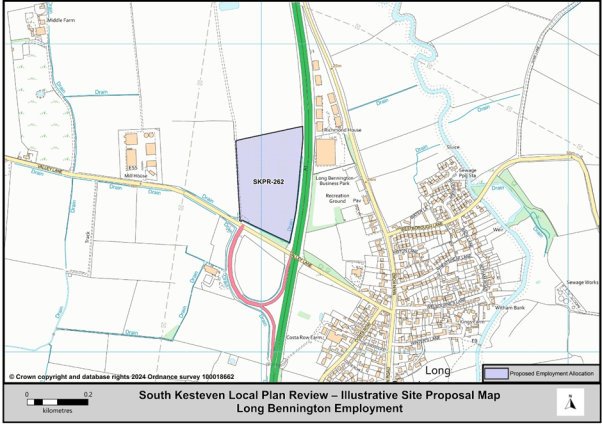
Figure 12: Long Bennington Employment Site
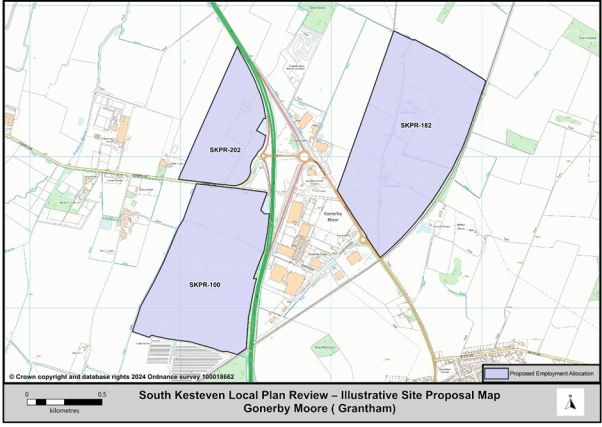
Figure 13: Gonerby Moore Employment Sites
Summary of Proposed Changes
Current Local Plan Policies E2 (Strategic Employment Sites) and E3 (Employment Sites) have been combined for clarity. Policy E2 and Policy E3 details the employment allocations contained within the adopted Local Plan. Policy has been amended to reflect new use class definitions.
As recommended by the Employment Land Study (2023) it is proposed that sites SKPR-202, SKPR-100, SKPR-182, and SKPR-262 be allocated for employment generating uses.
As recommended by the Employment Land Study (2023), it is proposed that current Local Plan allocations BO-E1 Land adjacent to A151 Raymond Mays Way (Elsea Park) and ST. E1 Exeter Fields, Empingham Road, be deallocated as employment sites.
Current employment allocation GR-E1 (Prince William of Gloucestershire Barracks) has been removed as a separate employment allocation and is now to be delivered as part of a mixed use development (SKPR-65 (GR3-H4)).
Criteria has been added to ensure the sites provide mandatory biodiversity net gain.
Illustrative Maps showing the context of the employment allocations have been added.
(4) Policy E4 - Protecting Employment Generating Sites
9.36 The National Planning Policy Guidance requires plan makers to be proactive in identifying as wide a range of sites as possible, including existing sites that could be improved, intensified or changed. In respect of existing employment sites. The Employment Land Study (2023) assessed whether they continued to be fit for employment purposes. The results of this assessment have been incorporated into the policy below (E4) which seeks to protect existing employment sites which are suitable for continued employment uses and provided locally important employment.
9.37 The list of protected employment sites outlined in policy E4 below can be identified within the South Kesteven Local Plan Review Policy Maps
Policy Type: Minor Changes to Policy
E4: Protection of Existing Employment SitesThe following locally important employment sites will be protected to ensure continued provision of locally important employment opportunities. Appropriate proposal for new B2 and/or B8 uses and/or redevelopment of for B2 and/or B8 as well as other employment generating uses that are within the E(g) use class will be supported where proposals:
Grantham
Stamford
Bourne/The Deepings
Rural Sub Areas
Other employment generating uses that are within the E(g) use class may also be appropriate and will be considered where the promoter actively engages with the Council and an end-user for the proposal has been positively identified. Additionally the local planning authority may seek to apply conditions limiting the ability to change use to other uses within use class E without the need for planning permission. |
Summary of Proposed Changes
Sites within Policy E4 has been updated to reflect the use class changes.
Sites within Policy E4 have been updated to match the recommendations set out within the Employment Land Study (2023)
The table within policy E4 has been broken down into sub sections and re-ordered to improve clarity.
(2) Policy E5 – Expansion of Existing Businesses
9.38 Proposals which provide for or assist in the creation of high quality employment and business development and inward investment, provide for the adaptation and expansion of local firms and allow accessible and equitable job opportunities for all will be permitted.
Policy Type: To be reviewed once evidence is finalised
(2) E5: Expansion of Existing Businesses
The expansion of existing businesses will be supported, provided that:
- existing buildings are re-used where possible;
- vacant land on existing employment sites is first considered;
- the expansion does not conflict with neighbouring land uses;
- the expansion will not impact unacceptably on the local and/or strategic highway network; and
- the proposal will not have an adverse impact on the character and appearance of the area and/or the amenities of neighbouring occupiers.
(7) Policy E6 – Loss of Employment Land and Buildings to Non-Employment Uses
9.39 It is essential that a sufficient amount and range of employment land is maintained throughout the city to ensure that the city's economy continues to grow, and residents have access to job opportunities. This objective is achieved in part through the allocation of land in this Plan for employment purposes and this Policy seeks firstly to protect these allocated sites from undesirable redevelopment or conversion for non-employment uses. It is also important to ensure that existing non-allocated employment sites are also retained for employment use wherever possible.
Policy Type: Minor Changes to Policy
(4) E6: Loss of Employment Land and Buildings to Non-Employment Uses
The Council will seek to retain and enhance existing areas of employment use, as well as the sites identified in Policies E1 to E4, and mixed use policies GR3-H1 (Spitalgate Heath) and GR3-H4 (Prince William of Gloucester Barracks) and SKPR-268 Station Approach (Land at Grantham Train Station)unless it can be demonstrated that:
- the site is vacant and no longer appropriate or viable as an employment site – this may include the need for an effective, robust and proportionate marketing of the land and buildings to be undertaken; or
- redevelopment would maintain the scale of employment opportunities on the site, or would deliver wider benefits, including regenerating vacant or unutilised land; or
- the alternative use would not be detrimental to the overall supply and quality of employment land within the district; or
- the alternative use would resolve existing conflicts between land uses.
Summary of Proposed Changes
Policy updated to include mixed use policies. Reference to policy numbers will be updated for the pre-submission Local Plan.
(3) Policy E7 - Rural Economy
9.40 Whilst a significant proportion of the population lives in rural areas outside Grantham and the three main towns of South Kesteven, the majority of employment-generating development is within the four towns.
9.41 There are some limited employment opportunities in most of the larger villages, including self-employment and home working, but generally outside the four towns, agriculture still remains the major source of employment. The National Planning Policy Framework recognises the need to support sustainable growth and businesses in rural areas, and also that diversification into non-agricultural use is important to ensure the continuing vitality of rural areas. Local authorities are encouraged to establish criteria to be applied to planning applications for farm diversification, and to support diversification for business purposes.
9.42 Intensive agriculture for food production forms a key economic feature of South Kesteven's extensive rural area and there are many food processing and distribution businesses dependent upon this key sector of the economy. Some types of business are quite naturally accommodated in the countryside or on the edges of rural settlements based on the rural economy. For some sectors such as agri-food, horticulture and tourism, it is important to acknowledge that this kind of discrete development should be supported where it is demonstrated to be sustainable and appropriate.
Policy Type: To be reviewed once evidence is finalised
(2) E7: Rural Economy
Proposals for the following types of small business schemes will be supported, provided that it is demonstrated that the business will help to support, or regenerate the rural economy:
Farming;
Forestry;
Equine;
Rural enterprise;
Sport and Recreation; and
Tourism
Proposals must demonstrate that they meet all of the following criteria:
- be of a scale appropriate to the rural location;
- be for a use(s) which is(are) appropriate or necessary in a rural location, providing local employment opportunities which make a positive contribution to supporting the rural economy;
- the use / development respects the character and appearance of the local landscape, having particular regard to the Landscape Character Assessment, and will not negatively impact on existing neighbouring uses through noise, traffic, light and pollution impacts; and
- avoid harm to areas, features or species which are important for wildlife, biodiversity, natural, cultural or historic assets, including their wider settings.
Schemes will also be required to ensure that the development meets the requirements of national and local planning policies which control the form, scale, design and impact of new development.
Any new building or extension to an existing building will only be permitted where it is clearly demonstrated that it is an essential element of the viability of the business proposal. The scale, design and construction of any new building or extension must be appropriate to its rural setting and fully justified by the business proposal.
Proposals which generate high levels of visitor traffic or increased public use, such as large scale sport and leisure facilities should only be permitted within or on the edge of the towns and Larger Villages, or where they can be easily accessed by public transport, foot and cycle.
(2) Policy E8 – Other Employment Proposals
9.43 Employment proposals not covered by the policies above could include retail development (including warehouses, clubs and factory outlet centres); leisure and entertainment facilities, the more intensive sport and recreation uses (including cinemas, restaurants, drive-through restaurants, bars and pubs, night-clubs, casinos, health and fitness centres, indoor bowling centres, and bingo halls); offices; and arts, culture and tourism development (including theatres, museums, galleries and concert halls, hotels and conference facilities).
(1) E8: Other Employment Proposals
Other employment proposals in locations not covered by the above policies will be supported, provided there is a clear demonstration that;
- there are no suitable or appropriate sites or buildings within allocated sites or the built up area of existing settlements;
- there is no significant adverse impact on the character and appearance of the area and the amenity of neighbouring uses;
- there is no significant impact on the local highway network;
- there is no significant likely adverse impact on the viability of delivering any allocated employment site; and
- there is a business case which demonstrates that the business requires a location outside an allocated employment site.
(1) Policy E9 - The Visitor Economy
9.45 The visitor economy is an important part of South Kesteven's local economy. In 2021, the District attracted 2.72 million visitors, generating over £168.63 million and supporting 2,232 jobs. In addition to the architectural and historical beauty of the District's villages, countryside and natural environment, other major attractions within the District include Belton House, Woolsthorpe Manor, the Georgian heritage of Stamford, Grimsthorpe Manor, Easton walled garden and St Wulfram's Church in Grantham. The rural parts of the District provide attractions through walking and cycling routes, canal and waterways, aviation history and other varied attractions. The importance of this sector is recognised by the GLLEP Strategic Economic Plan. It is also important to support sustainable rural tourism and leisure developments where these will benefit rural businesses, communities and visitors and enrich the character of the local area.
Policy Type: Minor Changes to Policy
(3) E9: Tourism andVisitor Economy
Proposals for development of the local visitor economy will be supported where they:
- allow provision for visitors which is appropriate in use and character to South Kesteven's settlements and maintains the quality of the countryside and the natural environment;
- enhance existing tourist and visitor facilities; aid the retention and/or enhancement of existing overnight accommodation and the provision of new overnight accommodation;
- allow new tourism provision and initiatives where these would also benefit local communities and support the local economy; or
- allow new tourism development of an appropriate scale and use which utilises existing historic buildings in the countryside whilst respecting their character.
In all cases proposals should be of a scale appropriate to the setting of the area and a sequential test should be applied where appropriate.
Proposals which generate high levels of visitor traffic or increased public use of tourist facilities should only be permitted within or on the edge of the towns and Larger Villages, or where they can be easily accessed by public transport, foot and cycle.
To ensure that tourism-related development does not result in the creation of permanent living accommodation, conditions may be imposed which restrict the use and/or period of occupation.

